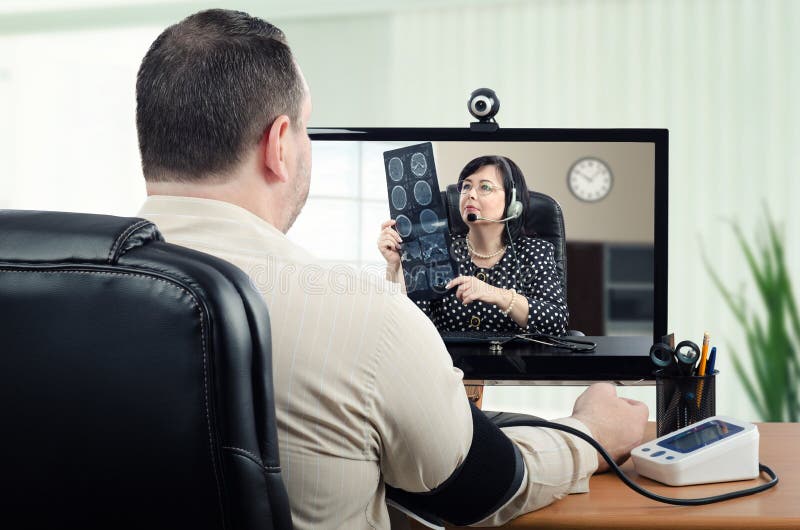Exactly How Teledoctors Are Changing Modern Medical Care
Exactly How Teledoctors Are Changing Modern Medical Care
Blog Article
Teledoctors: Linking the Space In Between Patients and Medical Care Service Providers
The emergence of teledoctors stands for a substantial change in the medical care landscape, providing solutions to long-lasting accessibility concerns dealt with by suppliers and individuals alike. By integrating telemedicine into conventional techniques, healthcare systems can reach underserved and remote populations, providing crucial clinical consultations without the obstacles of range and traveling. This paradigm shift not just boosts person involvement however also enhances resource allowance for suppliers. However, the extensive adoption of teledoctors raises crucial questions concerning the sustainability of such methods and the effects for future health care delivery. What obstacles lie ahead in guaranteeing this design's effectiveness and equity?
Surge of Telemedicine

The increase of telemedicine is likewise sustained by the demand for cost-effective medical care. Medical care systems globally are under pressure to minimize expenditures while keeping quality care, and telemedicine offers a practical solution. By decreasing the demand for physical sees, telemedicine minimizes overhead prices for healthcare centers and inevitably lowers the financial worry on clients.
Additionally, the COVID-19 pandemic worked as a catalyst, accelerating the fostering of telemedicine techniques. Social distancing measures and the need to minimize exposure threat required a shift in the direction of remote assessments, prompting regulative bodies to support and adapt telehealth services. This change has not just tested telemedicine's effectiveness however also its prospective to develop as a staple element of contemporary medical care systems.
Benefits for Clients
Primarily, telemedicine enhances ease of access, enabling clients in underserved or remote locations to speak with health care service providers without the demand for comprehensive traveling. Telemedicine also uses individuals the comfort of getting medical advice and treatment from the comfort of their homes, reducing the time and price associated with taking a trip to a health care center.
Moreover, telemedicine supports connection of care by facilitating regular follow-ups and monitoring, which are essential for managing chronic problems. Individuals can conveniently schedule appointments and gain access to medical care solutions outside conventional office hours, suiting their hectic way of lives. This versatility results in enhanced patient engagement and adherence to treatment strategies, possibly resulting in much better health results.
Furthermore, telemedicine can aid reduce the threat of infection transmission, an issue enhanced by the COVID-19 pandemic. By reducing the requirement for in-person check outs, clients can avoid congested waiting areas and minimize exposure to infectious health problems. Eventually, telemedicine empowers individuals by supplying prompt, reliable, and individualized health care services.
Benefits for Companies
For health care carriers, telemedicine supplies significant benefits that boost the efficiency and reach of their method. By leveraging electronic innovation, providers can expand their solutions to a broader demographic, consisting of those in underserved or remote areas. This not only eases geographical barriers however likewise optimizes individual retention and acquisition by making medical care much more accessible.
One more trick advantage is the reduction in above expenses. With telemedicine, the demand for physical space reduces, enabling carriers to minimize realty and functional costs. Moreover, telemedicine promotes better time administration by reducing the requirement for travelling and permitting for even more flexible scheduling. This versatility can bring about raised patient assessments daily, consequently enhancing earnings possibility.
Telemedicine likewise fosters an extra collective environment for Click Here medical care service providers. teledoctors. It allows smooth sharing of patient info among professionals, enhancing diagnostic precision and therapy results. Furthermore, digital platforms can incorporate with electronic wellness documents (EHRs), boosting data precision and improving administrative jobs
Additionally, telemedicine improves client complete satisfaction, which is important for company credibility and success. By providing prompt and convenient care, service providers can improve patient commitment and interaction, better strengthening the provider-patient partnership.
Conquering Challenges
While telemedicine uses many benefits for medical care suppliers, it also provides obstacles that need mindful factor to consider. Health care companies need to stick to rigid policies like HIPAA to safeguard delicate info, consequently requiring investment in secure systems and recurring staff training. teledoctors.
One more obstacle is the digital divide, which can hinder access to telemedicine services. Not all people have equal access to the necessary technology or web connectivity, specifically those in underserved or country locations. This variation can worsen existing health care inequalities, making it important for companies to discover different solutions, such as collaborations with area companies, to link this gap.
Moreover, there are limitations in performing physical evaluations from another location. Certain problems require in-person assessment, highlighting the need for a hybrid model that incorporates telemedicine with conventional sees. When telemedicine is proper and guaranteeing smooth transitions in between in-person and online treatment., providers need to navigate these difficulties by developing methods to recognize.
Future of Medical Care
The future of healthcare is positioned for a transformative advancement, driven by the fast combination of modern technology and innovation. Central to this shift is the rise of telemedicine, which is redefining just how clinical services are hop over to these guys accessed and delivered. With advancements in data, telehealth platforms are ending up being much more sophisticated, supplying real-time consultations, remote individual monitoring, and individualized care plans. This not only boosts patient convenience but likewise increases accessibility to medical care, especially in underserved and country areas.
Synthetic knowledge (AI) and maker discovering are likewise readied to play essential duties. These modern technologies can evaluate vast amounts of data, providing anticipating understandings into person health, improving diagnostic precision, and individualizing treatment strategies. AI-driven devices can enhance doctor' capabilities, bring about even more informed decision-making and much better person end results.
Furthermore, wearable modern technology and Web of Clinical Things (IoMT) devices are reinventing person interaction and proactive health and wellness administration. These devices make it possible for continual wellness tracking, enabling for very early detection of timely interventions and potential issues.
As these innovations remain to breakthrough, they assure to create a my review here more reliable, available, and patient-centric medical care system, ultimately bridging the space in between people and doctor. - teledoctors
Verdict
Teledoctors are transforming healthcare by significantly boosting access and performance via remote examinations. This innovation supports individuals in underserved areas by providing prompt medical recommendations without calling for physical gos to, thus boosting person involvement and continuity of treatment. Doctor gain from more reliable time administration and enhanced collaboration chances. Despite obstacles such as technical obstacles and regulative issues, the future of medical care appears reliable and increasingly inclusive because of the combination of telemedicine right into typical treatment models.

As telemedicine continues to reshape healthcare distribution, clients stand to obtain dramatically from this improvement. Mainly, telemedicine improves access, enabling people in remote or underserved areas to consult healthcare suppliers without the demand for substantial travel. Telemedicine also offers people the ease of receiving medical suggestions and therapy from the comfort of their homes, decreasing the time and expense associated with taking a trip to a healthcare facility.
Inevitably, telemedicine empowers clients by providing timely, reliable, and personalized healthcare services.
Report this page